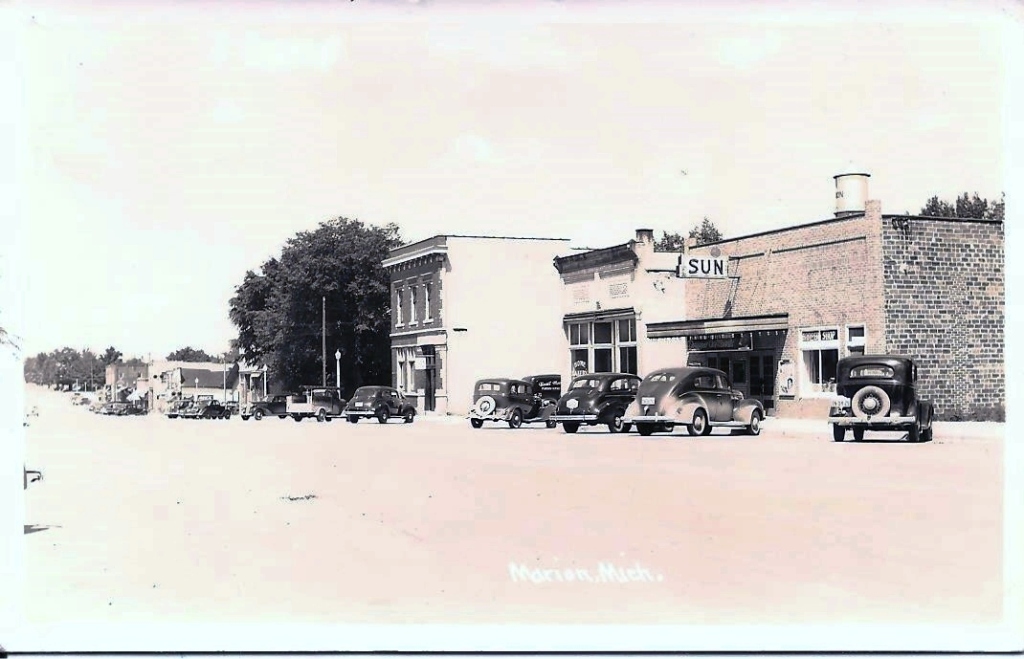
Forever and always are two words that we all use often and yet, in the long run, there are few things around us that are either. Our surroundings change all the time. Marion hasn’t always been here. Our families change, kids don’t stay the same little people forever. Home is always home, but it too changes in big and small ways.
We notice questions on the Marion Community page about places and buildings in our town that have obviously changed. Questions that ask what this was, and why isn’t it now? Many of the answers involve the phrases ‘always was’ and ‘gone forever. Yes indeed, there’ used to be’ and we ‘used to have’ a lot of things. Sad but true, they are no longer found here or in most small towns these days. But we all like to remember the likes of the drug store and the Ben Franklin and we like to keep them alive in our lore.
For those new to the Village and those who may have forgotten things long gone, it’s time to stroll along Main Street and remember how and what we used to be. Our old friend, Jim Baughan brought along a great picture postcard, taken on Main Street in Marion, Michigan, between 1938 and 1942. Some would call this time Marion’s the best of hay days. We were a farming community, coming out of a long economic depression. Times were indeed better. We were on the edge of the influx of gas and oil exploration. And WWII would soon change a lot of things here. The Village posed for several such photos along Main Street the day the photographer came to town and we looked very good.
The point of view in this photo is from in front of the current post office on east Main. The Richardson building (Shanajac’s Pizza) would be built just to the right of the Sun Theater. The Sun, built in 1938, is new and has its original marquee. The building was the Home Bakery and had been a bakery for several decades. It ended its life as the office of Doran Realty.
On the corner we see the original Marion Bank, the institution and the building. It was constructed of brick following a fire in the spring of 1908 which took the entire block, with the exception of the bank vault. Marion’s bank was truly grand, faced with brown glazed brick, large windows and finished lavishly with oak paneling, woodwork, fixtures and furniture. It possessed the latest safe with a massive door.
The Marion Bank became a branch of the Cadillac State Bank in 1943 and remained under that umbrella. Cadillac became NBD Bank, who made the decision in 1978 to purchase the two buildings, tear down all three, and construct the building we have today. In the 45 years since, we’ve lost count of the various banking names for which Marion was a branch. Each time a vehicle pulls in the bank drive, it passes through the barber shop and lobby of the Sun, through the Home bakery, to park in the lobby of the old bank.
On the next corner are large trees (they are elms) on Main Street. They are growing from what was technically the Marion Music Bowl, a natural amphitheater of sorts and a very popular place for a long time. Thousands came to town in 1937 to hear a future governor on the stomp speak from our bowl. Summer music concerts were very popular as was the sledding in the winter. The 1960’s brought about the loss of the trees and eventually flames took the old, double building that backed it. The Marion Twp Hall, built in 1902 and Morton’s Hardware, a double building went up in some very mighty flames under the Gamble’s banner in 1972. The rubble was used to fill the bowl. Today this is the site of the Layline building and parking lot.
And so it goes down the street, building after building has changed or gone. The railroad depot, a very busy and important place in this town for the first 60 years its existence, is marked by our impressive Veteran’s Memorial. The long time ‘candy store/party store’ site is now a very nice deck/ patio on the east side of the river. Even the classic lamp posts seen here were removed.
I recently came across a line in a Marion Press from 1954. The minutes of the Village Council noted that the only bidder on the recently removed boulevard lighting was Chuck Hamming, a local welder, who purchased all 24 lamp posts for something like $26 and change. He was the sole bidder. Hamming’s home and welding shop was located on the corner of East Main and Lowry Street, at the village limits. The cast iron lamp posts were stacked next to his shop.
A lot of folks feared Hamming would cut up the posts and scrap them but he knew a good thing when he had them. Soon, a two-liner appeared on the Press Classified page under the For Sale header. The old Marion lamp posts were for sale, by the each. In 1955 they were, if memory serves correctly, listed in the neighborhood of $6 each. You carry it home. They were popular and ones in the best condition went first and fast.
The decision to remove the stately, glass globe topped, cast lamp posts in favor of tall, “phone pole” posts and brighter ‘vapor’ lighting was a very unpopular one. Those in favor called it progress. Those against said we were losing our small town character. It was both.
Marion replaced the utility poles with lamp posts and street lighting much like what we had more than 50 years after the originals were removed. Time and neglect has taken its toll, but if you know where to look, a few of the old lamp posts still stand about, tucked away in backyards.
